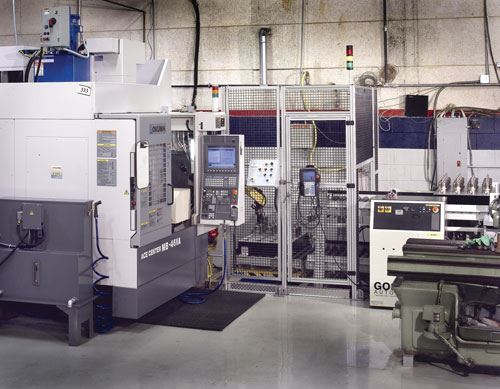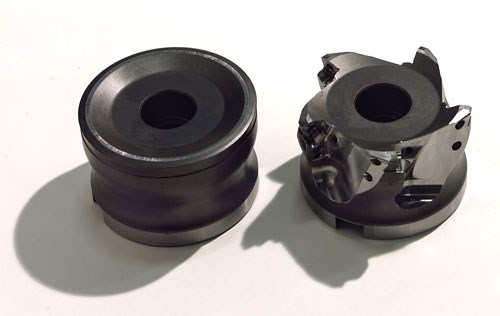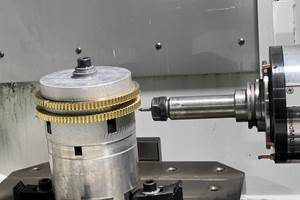Automation Helps Move To High-Volume Production
This tool manufacturer had to automate its processes after switching from low-volume special orders to high-volume production runs. Since implementing Tsudakoma tilting rotary tables along with robotics and a pallet conveyor, the shop has increased sales by 400 percent.
Share







Takumi USA
Featured Content
View MoreRFM opened its doors in 1978 and specialized in custom-designed indexable cutting tools manufactured specifically for the automotive industry. After steadily growing for 20 years, everything changed for the Brighton, Michigan-based shop. In 1998, Mitsubishi Materials USA took notice of RFM’s tooling expertise and manufacturing capabilities and purchased the company. Following the acquisition, RFM had to move from manufacturing low-volume specials to high-volume production of indexable, multi-pocketed milling cutters, end mills and drills.
To accomplish this, the shop planned to expand its facility from 6,000 to 7,500 square feet; hire two additional CNC operators; upgrade its current equipment; and purchase new, state-of-the-art CNC machines. The first investment was to retrofit two existing Okuma VMCs with new Tsudakoma TRNCB-301 tilting rotary tables and TPC M-code controllers (distributed in North America by Koma Precision). The clamping torque and accuracy provided by the rotary tables ensured that the machines could meet tolerances. As production volumes increased, the company replaced its older VMCs with new Okuma models, which were also equipped with Tsudakoma tilting rotary tables.
The additional 1,500 square feet of floor space quickly became occupied with the new machines. However, the new machines and the addition of a second shift still did not provide the extra production capacity the company had estimated. It became evident that stand-alone machines could not satisfy inventory demands. RFM and Mitsubishi Materials realized they needed productivity innovation to grow the business and supply an expanding world market. "The solution had to provide more with less," says Rudy Meffert, vice president and general manager of RFM.
RFM invited Gosiger Michigan, the regional Okuma distributor, to lend its expertise and provide input during the decision-making process. By the end of the meeting, Gosiger fully understood what the shop wanted to accomplish. The obvious solution was to automate RFM’s production methods. The initial investment for automation approximately equaled the cost of another machining center, and the projected payback would be generated in less than 1 year.
In July 2007, Gosiger delivered an Okuma MB46VA; a Tsudakoma TN-200 tilting rotary table equipped with a hydraulic pullstud device; a Fanuc M16iB robot with six axes of articulation; a Fanuc R-J3iC controller; and a Gosiger automation system consisting of three pallets that accommodate 25 workpieces on a conveyor with a load/unload station.
In place for more than a year now, the new automation system has delivered the increased production capacity RFM needed. In addition to the daily capacity the system provides, the shop enjoys an average of 8 hours of unattended machining on nights and weekends. The system can also be expanded to meet any future production requirements. And according to Mr. Meffert, the robot forced the company’s staff to improve their setup techniques.
Overall, the shop has increased production by 25 percent with the addition of the robotic system and no changes to its manufacturing staff. In addition, the company is better able to provide on-time delivery to its warehouse in Los Angeles. Since 2000, when RFM first began its productivity program with an investment in Tsudakoma rotary tables, sales have increased by 400 percent.
Related Content
3 Ways Artificial Intelligence Will Revolutionize Machine Shops
AI will become a tool to increase productivity in the same way that robotics has.
Read MoreFour-Axis Horizontal Machining Doubles Shop’s Productivity
Horizontal four-axis machining enabled McKenzie CNC to cut operations and cycle times for its high-mix, high-repeat work — more than doubling its throughput.
Read More4 Steps to a Cobot Culture: How Thyssenkrupp Bilstein Has Answered Staffing Shortages With Economical Automation
Safe, economical automation using collaborative robots can transform a manufacturing facility and overcome staffing shortfalls, but it takes additional investment and a systemized approach to automation in order to realize this change.
Read MoreIncreasing Productivity with Digitalization and AI
Job shops are implementing automation and digitalization into workflows to eliminate set up time and increase repeatability in production.
Read MoreRead Next
Registration Now Open for the Precision Machining Technology Show (PMTS) 2025
The precision machining industry’s premier event returns to Cleveland, OH, April 1-3.
Read MoreBuilding Out a Foundation for Student Machinists
Autodesk and Haas have teamed up to produce an introductory course for students that covers the basics of CAD, CAM and CNC while providing them with a portfolio part.
Read More5 Rules of Thumb for Buying CNC Machine Tools
Use these tips to carefully plan your machine tool purchases and to avoid regretting your decision later.
Read More



































.jpg;maxWidth=300;quality=90)
















